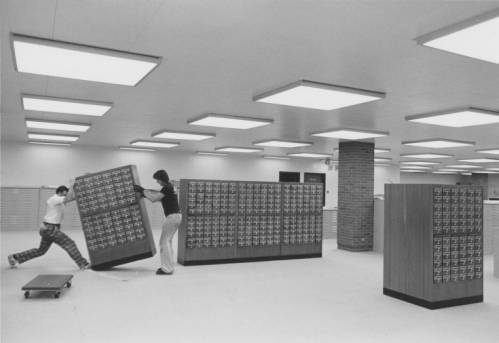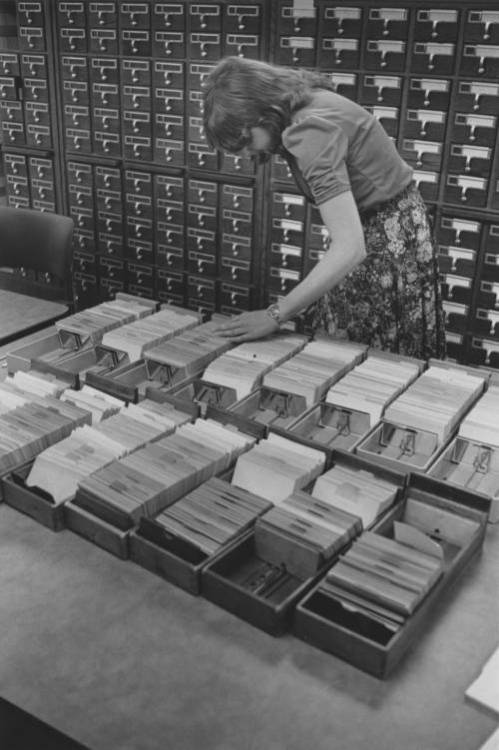#cataloging


Les siècles se rencontrant : Juives : La mère et la fille. DS 135 .G72 M47 C67 1917
Newly catalogued for the Jewish Salonica Postcard Collection: Two centuries meeting – the mother and daughter, circa 1917.
“A mother and her daughter walk down a street in Salonica (Thessaloniki, Greece) around 1917, as depicted in this historical postcard newly cataloged and added to our Jewish Salonica Postcard Collection. The mother is in a traditional Jewish dress while the daughter wears a modern Parisian one.”

Newly gifted to the Joseph A. Labadie Collection: Der frayer gedanḳ (La pensée libre), a Yiddish monthly Anarchist journal published in Paris and Tel Aviv between 1949-1963. Read more!


Salonicco : Cimitero Israelita DS 135 .G72 T41 C46 1917
“With more than 300,000 graves, the Jewish cemetery of Salonica (Thessaloniki, Greece) depicted in this postcard was one of the largest Jewish cemeteries in Europe. This cemetery was also an outstanding symbol of the centuries-old Jewish presence in the Balkan port-city and capital of the region known as Macedonia – grave stones that have survived are dated back to 1493.
Initially located in the periphery of Salonica, the Jewish cemetery eventually became a central area as the city expanded eastward. After the Great Fire of 1917, new urbanistic plans proposed the expropriation or transfer of the cemetery. In the 1930s, parts of the Jewish necropolis were given to the University of Thessaloniki…” Read more!

Salonique 1917: Le Quartier israëlite détruit. Special Collections Research Center DS 135 .G72 T41 Q37 1917


Salonique: Incendie des 18-19-20 Août 1917 DS 135 .G72 T41 I53 1917
“Located between the Mediterranean Sea and the Balkan Peninsula, the port city of Salonica (Thessaloniki), Greece, is in the intersection of two different climatic zones – a geographic situation that creates high variations in atmospheric pressure during the year. In several occasions through the centuries, the strong winds that blow from the north down the Vardar valley whipped up fires that quickly spread, causing significant damage and devastation in the city. The fire that sparked in Salonica on Saturday, August 18, 1917 was of unprecedent scale and changed completely the physiognomy of the city. The fire burned a large part of the historic city center, where several predominantly Jewish neighborhoods were located, leaving a large part of the city’s population homeless – approximately 56,000 Jews, 15,000 Christians, and 10.000 Muslims had their houses consumed by the fire. After the fire, a new urbanistic plan was implemented under the leadership of two famous architects, Ernest Hébrard of France and Thomas Mawson of England. The majority of the Jewish residents who lost their houses, now impoverished, were transferred to peripheral areas of the town, such as the Regie Vardar and Campbell districts. Dozens of postcards depicted the great fire of 1917, including the two featured here, which were purchased by the Special Collections Research Center with the generous support of the Lucius N. Littauer Foundation and the Solovy Judaica Book Fund.” Read more!


Salonique: Synagogue des Italiens. Circa 1917. Special Collections Research Center. DS 135 .G72 T41 S96 1917
Enjoy a recently catalogued item for the Jewish Salonica Postcard Collection.


Costume de femme juive (Souvenir de Salonique), 1917. Éditeur: Albert Barzilai. Special Collections Research Center DS 135 .G72 T41 S68 1917
Enjoy a recently catalogued item for the Jewish Salonica Postcard Collection.
Today’s post comes from Violet Fox, who previously wrote ourpost about Henriette Avram. Violet is on Twitter at@violetbfox.
Margaret Mann (1873-1960) was a librarian and educator whose work and scholarship emphasized the role of theory in cataloging and classification. Her passion for information organization inspired the many students she taught to see cataloging and classification as an essential service to library users.
Born in Cedar Rapids, Iowa on April 9, 1873, as an adolescent Mann moved with her family to Chicago and graduated from Englewood High School. She enrolled at Chicago’s Armour Institute in 1893, as one of the first twelve students in the library program (the Armour Institute was only the fourth school for the education of librarians in the U.S. and the first west of the Alleghanies). There she studied preservation, cataloging, accessioning, and shelf-listing, as well as learning library hand. After graduating a year later, most of her cohort moved on to library jobs, but Mann was asked to stay on as an assistant at Armour, serving as a cataloger and occasional instructor. When the library science department was moved from Armour to the University of Illinois in 1897, Mann was appointed to the staff of the new program. While teaching at the University of Illinois, she also worked towards creating consistent policies of cataloging and classification within its library. Mann moved on to the Carnegie Library in Pittsburgh in 1902, serving as head of the Cataloging Department until 1919. From 1919 to 1924 she undertook a massive reorganization of the collections of the Library of the Engineering Societies in New York City.
After returning from teaching cataloging and classification at the École de Bibliothécaires in Paris in 1926, she began as an instructor at the University of Michigan as one of the first three faculty hired at the beginning of the school’s library science program. Unlike her own library school experience thirty years earlier, which was highly focused on everyday library practice, Mann’s publications and teaching focused on the need to understand the theory of cataloging and classification to serve library users well. Her textbook, “An Introduction to Cataloging and the Classification of Books,” first published in 1930 by ALA, was widely used by library schools and helped standardize the cataloging content taught to library students. She would remain at the University of Michigan until her retirement at age 65 in 1938, impressing upon her many students the important role of information organization in libraries.
Mann died in 1960 but her name and legend live on in the University of Michigan’s Margaret Mann Award, established in 1938, as well as in the Margaret Mann Citation, awarded yearly by ALA to recognize outstanding professional achievement in cataloging or classification. Mann was also listed within American Libraries’s 1999 article on “100 of the Most Important Leaders We Had in the 20th Century”.
Resources consulted:
Clack, Doris H. (1993). Education for Cataloging.Cataloging & Classification Quarterly, 16:3, 27-37, DOI: 10.1300/J104v16n03_04
Grotzinger, Laurel. (1970). Margaret Mann: The Preparatory Years.Journal of Education for Librarianship, 10:4, 302-315, DOI: 10.2307/40322089
University of Michigan Faculty History Project
Wikipedia biography of Margaret Mann
Happy National Library Week!
In honor of this week, here are some photos of when our library made it to Milwaukee! The first photo is moving trucks arriving to the library building, with a crowd awaiting it. Next is the card catalogs being placed in the AGSL, where they still reside today. Thousands of cards, some handwritten, were moved from New York City. Jovanka Ristic, who is the current Reference Librarian, is pictured cataloging a map, and in a map printed shirt! The last photo depicts “Susan Peschel [the current Visual Resources Librarian] inputs Current Geographical Publications with a microcomputer. Automation at last!” Some captions or were words were taken from Current Geographical Publications, Volume 51, number 11, December 1988.
Post link






